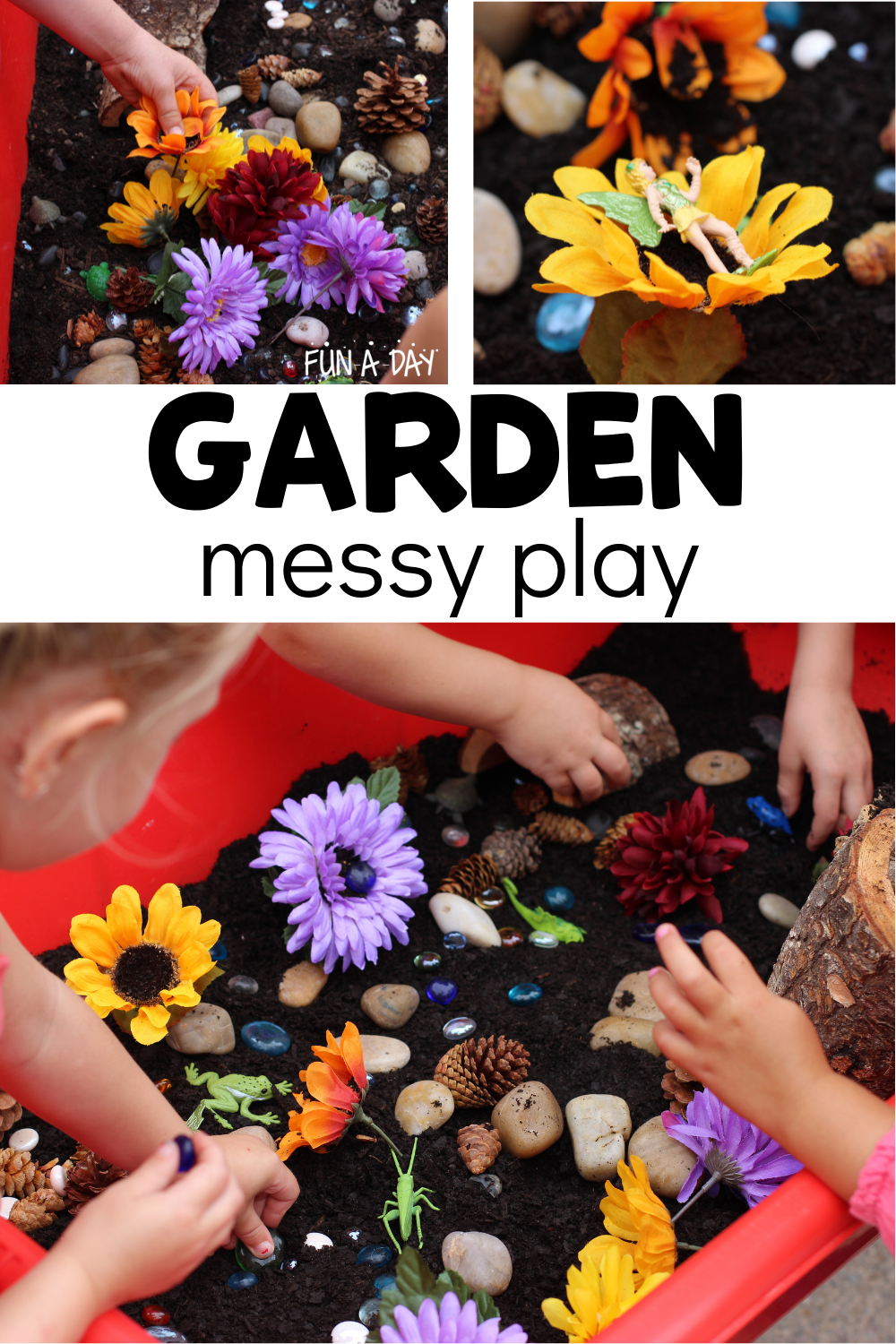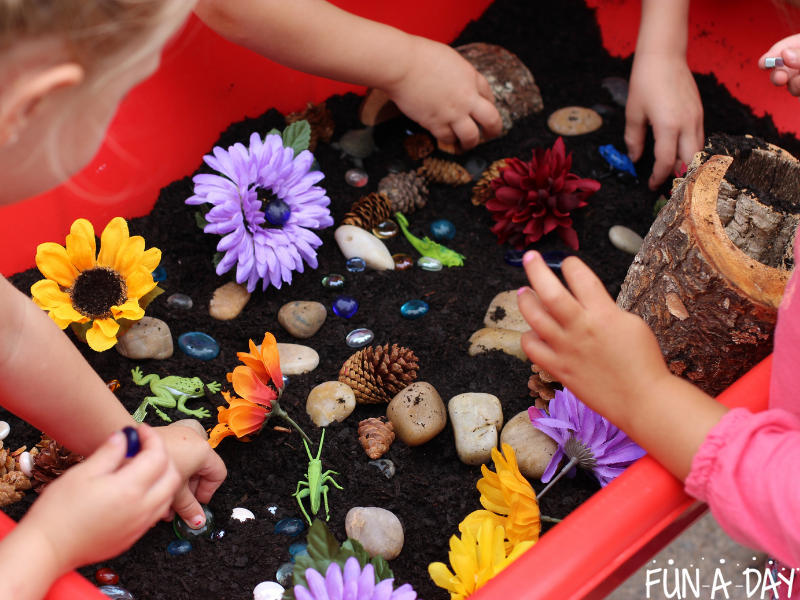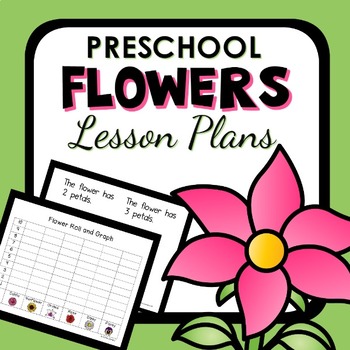Take the messy play outside this spring with a garden messy play invitation! Of course, if the weather interferes you can always put a tarp on the floor inside instead.
One of the best things about this garden small world is that the kids get to help put it together! AND you might even be able to make the sensory bin using mostly items you have on-hand.
This messy sensory play would be a great addition to a preschool garden theme or a flower theme. Of course, you don’t really need an excuse to break out the dirt! Any time will do!

Below, I’ll outline how we went about setting up the garden-themed messy play, as well as how the kids used it. Keep in mind, though, that you can change things up for your own students!
Garden Messy Play
This particular activity is part sensory bin and part small world . . . but all messy play! With young kids, pretend play often crops up in all kinds of activities, doesn’t it? This particular invitation adds a few pieces that encourage imaginative play (for those children who are interested).
Materials for the Garden Small World
For our garden messy play bin, I decided to use mostly items we already had on-hand.
- Potting soil/Topsoil/Dirt
- Bits of wood (found on sale at a local pet store)
- Rocks
- Pine cones
- Glass gems
- Fake flowers
- Safari Ltd.’s small toys
The only thing I had to grab was a bit of potting soil. Everything else was already in my stash. Keep in mind, I’ve been in early childhood education since 2001, so I’ve literally had decades to grow my supply stash!
Our toy additions might seem a bit random. We added fairies, frogs, turtles, a grasshopper, and a chameleon. The kids were originally thinking of making it a fairy garden, but it ended up expanding beyond that.
Garden Messy Play Directions
As I mentioned earlier, one of the best things about this garden sensory play is that the kids helped put it together. They helped me decide on most of the materials we used, and they’re the ones who set things up. I highly recommend doing the same with your students, taking their ages and needs into account of course!
So, here’s what the kids and I did in the form of “directions” you can choose to follow (or not):
First, grab a large sensory table, preferably with just one big bin. If you’d rather use a smaller table, or you only have a sensory table with multiple sections, that’s okay! I just found that one big bin worked best for this particular messy play invitation.

Related: Carrot Garden Sensory Bin
Next, dump in some potting soil, topsoil, or good old-fashioned dirt (taking care to read what’s in it if you purchased bags of soil). Spread the soil around, adding more if you want to.
After the dirt’s in place, it’s time to call in your assistants (a.k.a. your students). We chatted about what to add, and the kids decided the wood and rocks should go in first. I love the care they took when placing each of the items into the sensory table!
Once the wooden pieces and rocks are in place, add in the remaining materials. We added the glass gems, pine cones, and flowers next. Finally, add the pretend play elements – the fairies, frogs, reptiles, and insects.

Related: Spring Messy Play Ideas
And then it’s time for the children to play! Of course, my students were already in the midst of playing as they assembled the garden small world. And that was perfectly fine with me. If your kids help put the bin together, that might be the case with your children as well.
How the Kids Play and Learn
Oh, there was so much playing and learning with this garden messy play! It was awesome to observe everything the kids said and did. I think that’s one of my favorite things to do . . . just observe the children as they play and explore. Of course, there were a few points when I was invited to play, too (which is another one of my favorite things to do!).

Here are some things I observed as the children played:
- Some kids really enjoyed running their fingers through the dirt.
- Others had an absolute blast carefully placing each piece into the bin.
- Many of the children focused on the imaginative play aspect, telling stories as they moved the fairies and animals around the bin.
- “Planting” the flowers was a favorite activity for some of the children. They’d plant them, pick them, and then re-plant them over and over.
- There were ongoing discussions between the kids regarding where to put the materials, how to rearrange what was in the bin, and the imaginative stories told.
- Some children were incredibly interested in fairy lore; more than I realized! One child shared a few stories her parents had read to her, and she even told some of the other kids how to construct a fairy ring in the garden.

Related: Messy Play Benefits
Those are just some of the examples of how my students interacted with the garden messy play invitation. Your students might go in a completely different direction – there’s nothing wrong with that!
In terms of learning, the small world packs a punch. Here’s a list of some of the learning that can take place:
- Sensory exploration (particularly sight and touch)
- Fine motor skills
- Conversational skills
- Vocabulary development
- Story retelling
- Turn-taking
- Color identification
That’s not an exhaustive list, of course. Your own garden sensory bin might bring in different skill sets depending on a variety of factors. But no matter what, there’s a lot of learning and fun to be had here!
Additional Ideas for Your Garden Sensory Play
As with most open-ended activities, you can make a lot of changes to this garden messy play idea. The biggest one is incorporating your own materials rather than using exactly the same things we did. Here are a few other ways to tweak the garden small world:
- Keep it simpler with just dirt, rocks, and fake flowers. Or even just dirt and flowers! The children can pretend to be gardeners planting and harvesting flowers.
- Make it more elaborate with a complex fairy garden. You can incorporate homemade fairy houses, roads make of pebbles, etc.
- Swap out the dirt for something like black beans for a different sensory experience.
- Turn it into a vegetable garden messy play invitation! Add dirt, pretend vegetables, and kid-friendly gardening tools. Don’t forget the garden gloves!
- Turn it into a dirt and worms sensory bin, or an insects and dirt bin.

Those are just 5 additional suggestions. As you can see, the sky’s the limit in terms of changing things up. How would YOU and your students put this garden sensory bin together?
More Garden Messy Play Ideas
If your students love this garden sensory bin, I bet they’ll get a kick out of these ideas as well:
- Making a Play Garden
- Mud Soup Outdoor Sensory Play
- How to Make a Sensory Garden Table
- Counting Seeds Gardening Sensory Bin
- Spring Garden Fine Motor Play
Be sure to pin this post for future reference! I’m excited to hear what you and your students think of the garden messy play.
Garden Preschool Lesson Plans
Let Preschool Teacher 101 save you a ton of planning time with fully-developed, done-for-you preschool resources. This garden dramatic play pack has over 200 pages of materials to help you set up an epic garden center in your pretend play center! It includes setup tips, character badges, labels, signs, checklists, and more. Click on the image below to get your own:
Here are a few more resources you might like:

The post Garden Messy Play Small World appeared first on Fun-A-Day!.




